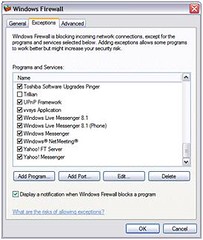August 2007
Rating: 4 Watertowers



This Blog has moved....please read this entry here.
All in all, a very nice, reliable application. Interestingly, Polycom’s headquarters is only about 30 miles away from Tracy in the Hacienda Business Park in Pleasanton, CA.
What is H.323 Videoconferencing?
To make a very long story (Yeoldetechy will be organizing a local seminar soon to explain it all) H.323 videoconferencing applications allow you to meet, and see, anyone with a similar system. The video and audio (and data) work over the Internet. Unlike ooVoo (see previous blog entry), the Polycom PVX is a “standards-based” application which means it can work with room based systems that your company, university, or school may already be using.
What is H.239 Data Conferencing?
Again the short story….this allows people in a videoconference to share their desktop computer with other videoconferencing participants. In the “old” days it was known as “People and Content”, which pretty much summed up it’s capabilities.
Now, with the great wisdom that comes with progress, we call it H.239….that does NOT sum up it’s capabilities. ![]()
What do I Need to Use the PVX?
Again, like in the ooVoo blog entry, you will need the following:
- A DSL or cable modem Internet connection
- A Windows PC running XP or Vista. NOTE: The Polycom PVX is NOT comaptible with Mac OS or Linux / Unix (and probably never will be)
- A web cam.
Basic PVX Features
Without getting really technical or introducing additional jumbled alphanumeric designations these are some of the basic features the PVX offers.
Advanced PVX features
For those who need to connect to their companies H.323 communication network, the PVX provides the following H.323 compatible features:
- Ability to assign a gatekeeper (an H.323 traffic cop)
- Enter an E.164 (assigned phone number or extension)
- Assign ports for communication for ease of firewall transversal (well..within limits)
- Statistics page that shows the connection information
- The Directory can register with a centralized database run by your organization
- The PVX allows you to set quality of service options for better video.
- Configure the PVX to work well with an internal management system from Polycom
- Alerts that tell you when something has gone wrong (camera not connected, network down, etc.)
- There is a keypad that provides telephone (dual tone multi-frequency--DTMF) signals for controlling an MCU or a Recording device
- There are zoom in and out and up, down, left and right camera controls. This allows you to control the persons camera at the far end (if they are allowing it and if there is a camera there that supports this).
The PVX user interface makes it very easy to move around and enter the information.
The robust set of features is second to none.
Yeoldetechy says: The PVX is a first class H.323 desktop videoconferencing application.
H.323 Gotchas
Firewalls and NATs (network address translators) block H.323 communication. This is due to the design of the H.323 standard and has nothing to do with the Polycom PVX design.
Getting an H.323 system to work from behind a firewall or NAT is the single most difficult task of all. Hopefully, your home network does not have firewalls configured, or it has H.323 aware firewalls (these are becoming more common). Otherwise you can pretty much say goodbye to H.323.
The PVX has some capability to recognize firewalls (and other blockers) and try to get around it to allow communication. This is very good, but, may not work in every instance.
The Windows XP firewall works great, however. After allowing “vvsys”, it opens up all the necessary ports to allow communication when calls are being made.
Sooooo, if you need to communicate with H.323 and need a firewall, you can implement the local Windows firewall and turn off the network firewall. This is more difficult to do at work than at home…to say the least.
The picture below shows the check mark allowing “vvsys” as an exception on my XP machine.

Can you really videoconference over the Internet?
YES, even for business purposes. This is a new world.
Summary
This is a difficult subject for a blog that is supposed to introduce technology to the regular person in a way that they can understand.
Although H.323 videoconferencing can be complicated, the basic use of it can also be very simple. For less than $200 a TeleWorker can have a great, fully featured, videoconferencing system that works well with the organizations videoconferencing rooms and infrastructure.
For the ordinary person using videoconferencing to talk with family or friends, the PVX can be used in it’s very basic mode and it will perform admirably.
Watch this video clip developed to help you understand H.323. It is very well done, but, even to Yeoldetechy, it is confusing…no wonder why videoconferencing has not taken off in the mainstream! To dang hard! It is time to change that…
